Kielce
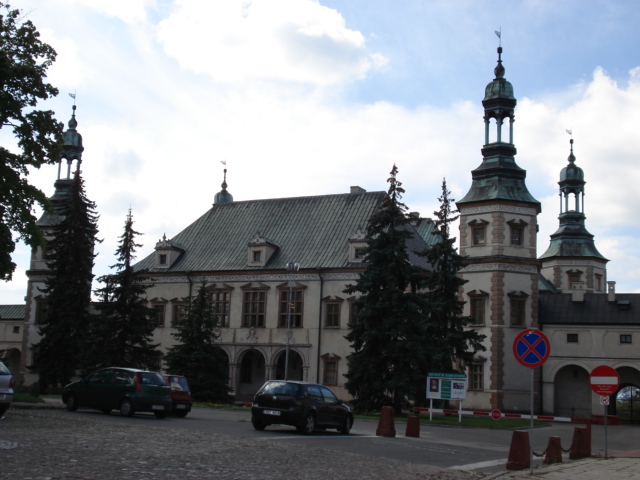
The Krakow Bishops' Palace in Kielce now houses the National Museum
Distance
Population
212.000 (2006)
Location and history
The regional capital of Kielce is located in the southeastern part of Poland, at the western edge of the Góry Świętokrzyskie mountain range.
An accurate time for the city of Kielce’s occurrence can be difficult to ascertain. Studies show that the beginning was a small settlement that developed as a center for the exchange of goods. In the 10th year. erected a church, consecrated to St. Wojciech. At the transition between the 10th and 11th years. the bishopric in Kraków became the owner of both the settlement and significant parts of the Góry Świętokrzyskie mountain range. The bishop built a diocese church on the mound of the city (now called the castle mound); this church was consecrated to the Virgin Mary. Polish chronicle Jan Długosz mentions that Krakow Bishop Gedeon built the city of Kielce in the distant uninhabited forests and therein a church in honor of God. The church building was completed in 1171, which is the first safe year in the city's history. The business community in Kielce developed significantly especially in the form of markets and other trade. In 1229 a parish school was established at the Diocese. In the middle of the 13th century. the development of the city was hampered in part by attacks by the Tatars as well as by the fighting in Poland. At the same time as the repair of the destruction in the city, a defense plant was erected outside the church on the bailey.
None of Kielce's original marketplace rights or letters of privilege have been preserved. However, it is known that letters of privilege issued by Leszek Biały in 1227 and a document issued by the Czech King Václav II in 1295, authorizing the construction of city walls and moat around a number of trading places, including Kielce. Based on the circumstances surrounding the latest document, it is believed that Kielce is already at the end of the 13th century. was considered to be a city. Term “civitas” (civil society or city), however, was first used in the sources in 1359. At the transition between the 14th and 15th centuries. Kielce is inhabited by approx. 300 people. In 1496, Kielce was awarded a city coat of arms: a golden crown on a red background and including the abbreviation CK (Civitas Kielcensis, ie Kielce Civil Society). The first artisan lawn in the city, the shoemaker's lawn, was founded in 1502. Two royal markets were granted a royal privilege. At the same time, a road was built for Bodzentyn; later several craftsmen 's camps emerged: blacksmiths, butchers and tailors. An urban center began to take the form of a square with streets leading from it: the present Bodzentyńska and Piotrkowska. In the middle of the 16th century. a one-storey town hall building was erected on the square.
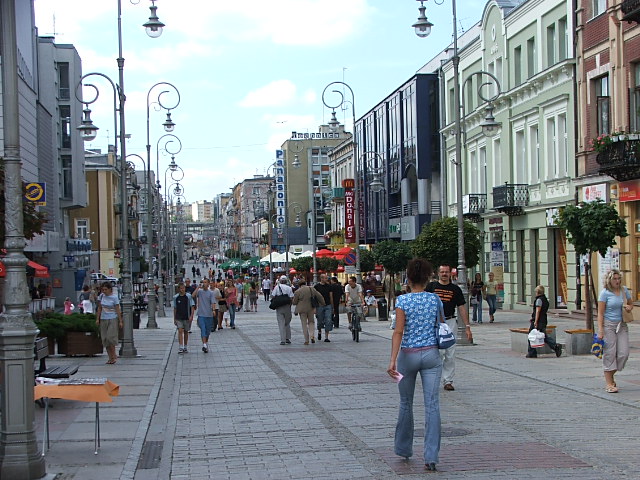
The pedestrian street ul. Henryka Sienkiewicza in the center of Kielce
The extraction of iron and precious metals in the Kielce sites contributed in the 16th and 17th centuries. strongly to the city's development and led to an increase in the city by specialists from other parts of Poland and from abroad, especially Italians, Hungarians, Slovakians and Germans. For several years, a mining authority existed in Kielce. Around 1500, the then Sandomierz county (a precursor to the later Kielce and even later Świętokrzyskie county) was one of the most important industrial areas in Poland. Here as many as 73 hammer works worked. In the Kielce area, metalworks, glassworks and workshops producing armor arose. By 1790, Kielce had become so significant that the town was chosen as the meeting place for the nobility assemblies in the Sandomierz area. It is known that in 1645 1250 people lived in the city. In the first half of the 17th century. a significant expansion of the city took place. Instead of the old wooden manor seat, a mansion was built, designed by the Italian architect J.Trevano, the Trinity Church and a hospital attached to it, and on the Karczówka hill the Bernardine order built a monastery and a church. The diocesan church was expanded with side ships, a choir as well as a brick bell tower in the cemetery around the church. The wars with the Swedes as well as civil wars in Poland hampered the development of the city: acts of war, looting and plague left its mark; only during the 18th century. returned prosperity. In 1780’The limes were started to extract limestone in a mine near Kielce and two brickworks started their business, new streets were built in the city and new houses built. Very important for the later development of the city was a law passed by the Polish Sejm, by virtue of which the bishop's properties, including the city of Kielce, were taken over by the royal administration.
At the third partition of Poland in 1795, Kielce lost its independence as the city became part of the province of Western Galicia, ie. Austria-Hungary. In 1800, a fire destroyed large parts of the inner city. In 1809, the city was part of the Principality of Warsaw, which was formally established in 1807, which was formally independent but was in fact subject to France. After Napoleon's defeat in Russia in 1812, but formally only at the Vienna Congress in 1815, the eastern part of the principality (with Kielce) was placed under Russia. The Polish November uprising of 1830 (aimed at Russia) and its consequences hampered the city's development for several decades. A magistrate's building erected in 1835 burned down in 1873. Two years later, local architect Franciszek Kowalski began planning a new town hall, which began to be commissioned in 1876. After several alterations and redevelopments, the building still stands today.
Under the Russian administration, a government was established that included the Kielce area and had this city as the administrative center. This government (Keleckaja Gubernija) served from 1841-1844 and again from 1867-1917.
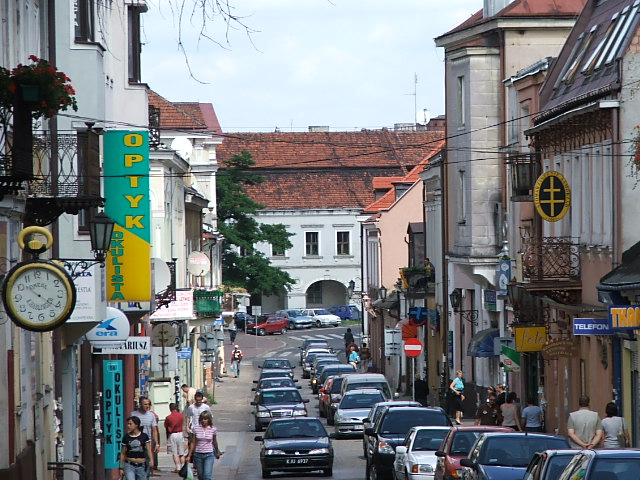
Street view from the old town of Kielce
Around 1875, 4 major industrial companies operated in Kielce: a brewery, a marble factory, a sawmill and a steam mill. A boom of business took place after the opening in 1885 of a railway line from Dęblin via Kielce to Dąbrowa Górnicza. New companies in the city were cooperative “Społem”, a glass factory and two lime kilns. A new theater and local newspaper as well as new hotels and churches also emerged in the late 1800s. In 1897 there were 13,500 inhabitants of Kielce. Under the Russian rule several resistance movements appeared in Poland, including in Kielce; many residents of the city were arrested for participation in uprisings and other resistance activities and sent captive to Siberia. A power plant originated in Kielce in 1913.
After World War I, in 1918, the city regained its independence after 123 years under foreign rule. Kielce now became the administrative center of a large county. Several buildings around the city were included in the urban area. In 1939, the population increased and reached more than 71,000 persons. Several new industrial companies (thus a castings factory, a furniture factory, several brickworks) and municipal works were added. In the 1930s, the Polish authorities established the Central Industrial Area (Centralny Okręg Przemysłowy, COP), which included parts of the counties: Kielce, Lublin, Kraków and Lwów. Within the framework of the COP, Kielce County was built, among other things. arms factories in Radom and Starachowice. Several newspapers and magazines began to appear in the city.
The new development in Kielce was interrupted by World War II. The German army ruled the city from the beginning of September 1939. Very early during the occupation, the city's president, Stefan Artwiński, was assassinated by the Germans because of resistance activities. During the occupation, several resistance groups in Kielce acted like a secret, ie. illegal, educational activities took place. Soviet army forces drove the Germans out of Kielce on 15 January 1945. After the war, the population had dropped to around 48,000.
A tragic event affecting the already severely affected Jewish community in Kielce was the pogrom on July 4, 1946. As a result of rumors that a boy of Polish nationality had been abducted by Jews, a crowd gathered in front of the Jewish Association building in Planty street; On this occasion, 42 Jews were murdered who had survived the German persecution. At the lawsuits that followed the pogrom, 9 people were sentenced to death for murder. Victims' memorials were erected in 1947 and again in 2006.
The post-war years were characterized by continuous development and expansion, not least in 1970’s. Several institutions of higher education emerged, among others. a polytechnic college and an educational college. By the end of 1970’the city numbered 160,000 inhabitants. Today, the main city of Świętokrzyskie county is in continuous development and now holds 212,000 inhabitants (2006). The city is the region's economic, cultural and scientific center; Kielce is thus an active fair city. Public and private colleges educate 40,000 students annually. The daily press reports the local press, the local television and radio.
Tourist attractions
Selected attractions:
Krakow Bishop's Palace (Pałac Biskupów Krakowskich) (Plac Zamkowy 1)
The mansion was built in 1637-44 at the initiative of the Bishop of Kraków, Jakub Zadzik. It is a valuable example of Polish residential buildings from that period, probably designed by the Italian architect T.Poncino, who also led the construction. The main building is on two floors and is surrounded by four hexagonal towers. The side wings were added in the first half of the 18th year. After the January uprising (1863-1864), the Russian authorities made extensive changes to the mansion. In 1866 the building was designed as a seat for the local authorities of the Kielce Government. In 1914 the mansion became the seat of the Commissariat of the Polish Army in Kielce and, not least, the permanent neighborhood of Józef Piłsudski. From 1919, the buildings came to accommodate the county administration of the new Kielce county. In 1971, the National Museum of Kielce was decorated in the buildings, including memorial rooms for Józef Piłsudski.
(See photo at the top of the page).
Cathedral of the Assumption of Mary (Katedra Wniebowzięcia Najświętszej Marii Panny)
The original Romanesque church was erected in 1171 by Bishop Gedeon of Kraków. It was built at the highest point (280 meters) in ancient Kielce and almost like a fortress, thus with two sliding towers, all erected in quarry stone. As a result of several extensions and extensions, i.a. in the 16th century, the church gradually lost its original appearance. From the beginning of the 18th century and by virtue of the redevelopment that took place there, the church was characterized by an early three-baroque-style basilica.
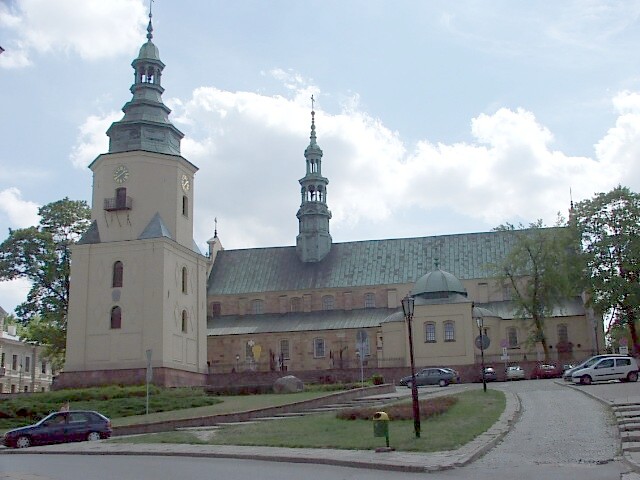
Cathedral of Kielce
The monastery and church on the Karczówka hill (Klasztor i Kościół na wzgórzu Karczówka)
The monastery complex was founded by Bishop Marcin Szyszkowski of Kraków as a votive gift because Kielce was saved from the plague that ravaged the country in 1622. The church, which was consecrated to Karol Boromeusz, was erected on the Karczówka hill, which was located just outside Kielce at that time. The church building was completed in 1628. In 1629 it was decided to summon monks to the place; therefore, extensions were made that were designed for monastic purposes.
Saint Wojciech’s Church (Kościół pw św.Wojciecha)
This church, the oldest in Kielce, first existed as a wooden church (of larch), erected in the 10th century. In 1763 a stone church was built to replace the older wooden church. This present church was greatly expanded in 1880’s.
Trinity Church (Kościół pw Świętej Trójcy)
The church is located at ul.Jana Pawła II in the middle of a number of buildings, built on one side with a museum for the author Stefan Żeromski and on the other a priest's seminary. Originally, there were 2 brick buildings next to a chapel; the buildings contained the Trinity Hospital. Instead of the chapel was built a church (consecrated in 1646), while the hospital buildings are not preserved.
Garrison Church (Kościół Garnizonowy)
The architecture of the church is reminiscent of the Byzantine, which is not strange as it is a former Orthodox church from 1902 that was built to serve the needs of the Russian garrison. In the interwar period, the church was renovated and furnished for the Roman Catholic service.
The Evangelical Church (Kościół Ewangelicki)
In 1835, the evangelical believers in Kielce and the surrounding area applied for land for the building of a church. This was granted and the church built between 1838 and 1840. The building style is classic and the building consists of a main ship and a tower to the north. Today, the church bears the name: Evangelical-Augsburg Church of the Holy Trinity.
Laszczyk Family House (Dworek Laszczyków)
On the southern slope of the castle mound, at ul.Jana Pawła II is an old house, called the Laszczyk Family House. The house is one of the most valuable building monuments in the city, not only because of its two-hundred-year history, but especially because it is the only preserved wooden building of this type in the city; it can therefore give the inhabitants as well as the tourists an impression of what the old buildings in this part of the city looked like. The house was built by the last star cheese of Kielce, Jakub Jaworski, who leased the land in 1788. In 1911 the property was purchased by Kazimierz and Julia Laszczyk. The family had plans for an extension, which was, however, interrupted by World War I. During World War II and the occupation, the house played an important role as a secret residence for people from the resistance movement and as a weapons stockpile.
Stadsparken (Park Miejski)
Kielce City Park, located in the city center between the streets of Zamkowa, Staszica, Paderewskiego, Ogrodowa and Jana Pawła II, is one of the oldest city parks in Poland. Along with the lake, the park covers 7 acres. The oldest, preserved, archival records that refer to the park as an Italian garden date from 1804.
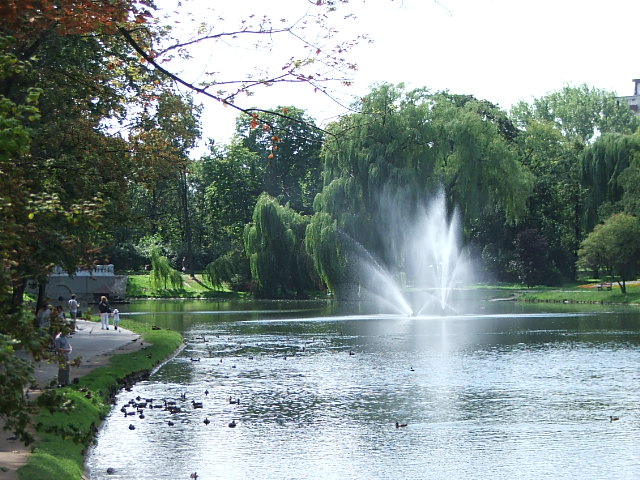
The lake in the city park in Kielce
The Old Cemetery (Cmentarz “Stary”)
“Stary” is the oldest of the 6 functioning cemeteries in Kielce. It is located (probably between 1801 and 1805) on an area that had belonged to the former diocese of Psiarnia. Previously dead had been buried in the cemetery at the Diocese of St. Wojciech’s Church and at St. Leonard's Chapel (no longer existing).
Museum of National Remembrance (Muzeum Pamięci Narodowej) (former prison)
The prison at ul.Zamkowa arose in 1826-28 and served as such until 1970’s. Under the Russian rule, the prison contained many Polish political prisoners. The most tragic period in prison history was the years 1939-1956. During the war, the prison was a gathering place for Polish prisoners of war. At one point, Gestapo took over the management of the prison. The prisoners were abused, murdered or transferred to concentration camps. In January 1945, for a few weeks, the Soviet security service NKVD took over the management of the prison, arresting Poles, including judges and prosecutors. Then the Polish Communist Security Service stood for the prison until 1956. Now the prison was filled with political prisoners who had opposed the communist regime or those who had fought against the Germans as members of non-communist groups during the German occupation, thus AK (Armia Krajowa – Home Army). In 1995, the National Remembrance Museum was opened in the former prison. The museum houses halls with, among other things. documents, visuals, weapons, torture tools, and records of prison history and the fate of prisoners. Preserved are penal cells in the original condition and a place of execution.

The defense wall on the castle mound in Kielce
Surrounding Area
Tokarnia (20 km southwest of Kielce)
Kielce Region Village Museum (Freelandsmuseum) (Muzeum Wsi Kieleckiej (Skansen))
Accommodation
Urząd Miasta Kielce (The official site of the city in Polish and English) – with practical information for tourists
Other Internet sites and sources
Urząd Miasta Kielce (The official site of the city in Polish and English)
Translated into English by Google Translate. Spangshus.dk accept no liability for any errors or omissions in translation.
Map

Rating
Search
Most used tags
churches (205) Castles (86) Monasteries (79) Town walls (74) Lakes (71) Town halls (67) Rivers (65) Castles1 (62) Mansions (55) Museums (51) Regional museums (38) Town gates (36) Abbey churches (35) Castle ruins (30) Cathedrals (26) Forests (25) Health resorts (24) Water sports (23) Mounds (23) National parks (22)Click for all tags
Denne side er også tilgængelig på dansk. This page and contents is (c) Copyright 2018- www.spangshus.dk. Based on Inviator software by ISCA Software